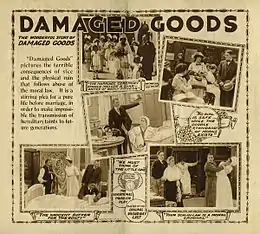| Damaged Goods | |
|---|---|
.jpg.webp) Advertisement for the 1917 edition | |
| Directed by | Tom Ricketts |
| Written by | Harry A. Pollard (adaptation) |
| Based on | Les Avariés by Eugène Brieux |
| Starring | Richard Bennett Adrienne Morrison |
| Cinematography | Thomas B. Middleton |
Production company | |
| Distributed by | Mutual Film Corporation |
Release date |
|
Running time | 7 reels |
| Country | United States |
| Language | Silent (English intertitles) |
Damaged Goods (1914) is an American silent drama film directed by Tom Ricketts, starring Richard Bennett. It is based on Eugène Brieux's play Les Avariés (1901) about a young couple who contract syphilis. No print of the film is known to exist, making it a lost film.[1] It is believed to have begun the sex hygiene/venereal disease film craze of the 1910s.[2]
The play was adapted into a British silent film Damaged Goods in 1919. A sound film based on the Brieux play, also titled Damaged Goods (1937) was directed by Phil Goldstone, released by Grand National Pictures.
Cast


- Richard Bennett as George Dupont
- Adrienne Morrison as a Girl of the Streets
- Maud Milton as Mrs. Dupont
- Olive Templeton as Henriette Locke
- Josephine Ditt as Mrs. James Forsythe
- Jacqueline Moore as Seamstress
- Florence Short as Nurse
- Louis Bennison as Dr. Clifford
- John Steppling as Senator Locke
- William Bertram as a Quack Doctor
- George Ferguson as the Quack's Assistant
- Charlotte Burton as Mrs. Lester
Production and release history
Film historian Terry Ramsaye stated that the film was "pretentiously made" for a cost of less than $50,000, including marketing, and that "its states' rights ... sold for $600,000, thus indicating a box-office take of probably more than $2,000,000".[3] According to a 1915 account, audience demand for the film in Detroit was so great that police were required to control the crowds at the theater.[3]
Damaged Goods was re-released in a "new edition" in 1917, perhaps in response to concerns about the spread of venereal disease among World War I soldiers. It was re-released again in 1919.[3]
Reception
The film was positively received by critics. Reviews in Variety and The Moving Picture World praised it as morally salubrious.[3]
See also
References
- ↑ "Damaged Goods". silentera.com. Retrieved March 17, 2013.
- ↑ Eric Schaefer, Bold! Daring! Shocking! True!: A History of Exploitation Films, 1919-1959 (Durham, N.C.: Duke University Press, 1999).
- 1 2 3 4 Schaefer, Eric (1992). "Of hygiene and Hollywood: origins of the exploitation film". Velvet Light Trap.